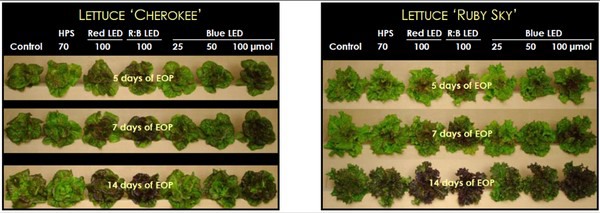Understanding the relationship between supplemental lighting and plant growth is key for high-quality greenhouse crop production. Red lettuce is a good example of how supplemental lighting can have a major influence on plant quality and ensure beautiful color year-round. In one of Heliospectra's webinars for master growers, Dr. Roberto Lopez of Michigan State University discussed how growers can significantly enhance the color, aesthetic value, and marketability of a lettuce crop using strategic supplemental lighting in the days leading up to harvest.
Why promote red pigmentation at end of production?
Anthocyanins are responsible for the red pigmentation in red lettuce leaves. The color concentration and distribution are, dependent on light quality and intensity. It’s important to note that anthocyanin production is a secondary metabolite, which diverts energy away from the plant’s primary metabolic processes, including biomass accumulation. So, light should be applied for growth first and then adjusted at end of harvest for finish, such as the desired red coloration.
Studying greenhouse lighting strategies for finishing red lettuce
Under low-light greenhouse conditions, especially in the winter and early spring, the foliage of red leaf lettuce often ranges from pale green to light purple, rather than the deep red consumers expect. To enhance the color and increase the product quality and aesthetic value of red lettuce in low-light greenhouse conditions, Dr. Lopez and his team conducted a study.
They supplied supplemental lighting at end of production to ‘Cherokee’, ‘Ruby Sky’, and ‘Vulcan’ foliage, using LEDs that provided 100% red light at 100 micromoles, 50% red light and 50% blue light at 100 micromoles, and 100% blue light at increasing intensities, from 25 to 100 micromoles.
Prior to introducing the supplemental lighting, the lettuce had little to no red pigmentation. They were grown under a relatively low daily light integral of 6 moles of light in the greenhouse. Then they were placed under the end of production supplemental lighting treatments. These included the control plants, which received only photoperiodic lighting for 16 hours at 4 micromoles; plants grown under HPS lighting; and plants grown under LED lighting at 100 micromoles as noted above.
When grown under a low greenhouse DLI, five to seven days of end of production supplemental lighting of 100 micromoles of red, red:blue or blue LED light promoted enhanced red pigmentation in the lettuce foliage. The control group of low-intensity photoperiodic LED and the supplemental HPS lighting group showed little to no signs of reddening (see below).

Image source: Dr. Roberto G. Lopez, Michigan State University 2020
Results
Dr. Lopez noted, “100 micromoles of either red, a combination of red and blue, or blue light led to increased anthocyanin production. However, the treatment that really provided the most intense coloration was a combination of red and blue at 100 micromoles.”
He continued, “Even within five days, we see [in the images above] that the crop obviously looks much better than the control. So, our conclusion is that anywhere from five to seven days of end of production supplemental lighting at 100 micromoles promotes red pigmentation of lettuce. This is becoming used throughout the world in terms of enhancing color with lettuce when you have relatively low daily light integrals.”
LED grow lights provide today’s growers with the ability to customize spectrums of light to fit various plant growth applications. They can provide the right light for your crops at each growth stage while taking into consideration your greenhouse’s natural seasonal light.
A copy of the eBook Producing High-Quality, Profitable Food Crops Faster is available here.

 Heliospectra
Heliospectra